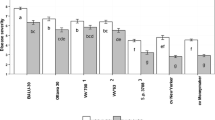Abstract
Cultural characteristics and pathogenicity tests showed that South Australian isolates of Leptosphaeria maculans (Desm.) Ces. et de Not. were highly variable. Isolates were ranked in a continuum based on the severity of disease symptoms on plants, and two of the 40 isolates tested showed very similar characteristics and pathogenicity to a known avirulent isolate. The early stages of infection, on the surface of leaves, through the epidermis and into the mesophyll, were examined histologically, using two canola cultivars (susceptible and resistant) and two isolates (virulent and avirulent). Differences in frequency of penetration into the plant tissue were observed indicating interactions between cultivars and isolates. Up to 6 days after inoculation, hyphae penetrated the stomata more frequently on the susceptible cv. Hyola 42 than on the resistant cv. Dunkeld. This was linked to the lower density of stomata per unit area on Dunkeld compared to Hyola 42.
Similar content being viewed by others
References
Annis SL, Goodwin PH (1997) Inhibition of polygalacturonase activity produced by Leptosphaeria maculans with stem extracts of canola, and the relationship of inhibition to resistance. Journal of Phytopathology 145, 217–223.
Ballinger DJ, Salisbury PA (1996) Seedling and adult plant evaluation of race variability in Leptosphaeria maculans on brassica species in Australia. Australian Journal of Experimental Agriculture 36, 485–488.
Chen CY, Howlett BJ (1996) Rapid necrosis of guard cells is associated with the arrest of fungal growth in leaves of Indian mustard (Brassica juncea) inoculated with avirulent isolates of Leptosphaeria maculans. Physiological and Molecular Plant Pathology 48, 73–81.
Chen CY, Plummer KM, Howlett BJ (1996) Ability of a Leptosphaeria maculans isolate to form stem cankers on Indian mustard segregates as a single locus. European Journal of Plant Pathology 102, 349–352.
Goodwin PH, Annis SL (1991) Rapid identification of genetic variation and pathotype of Leptosphaeria maculans by random amplified polymorphic DNA assay. Applied and Environmental Microbiology 57, 2482–2486.
Hammond KE, Lewis BG, Musa TM (1985) A systemic pathway in the infection of oilseed rape plants by Leptosphaeria maculans. Plant Pathology 34, 557–565.
Hammond KE, Lewis BG (1987a) The establishment of systemic infection in leaves of oilseed rape by Leptosphaeria maculans. Plant Pathology 36, 135–147.
Hammond KE, Lewis BG (1987b) Variation in stem infections caused by aggressive and non-aggressive isolates of Leptosphaeria maculans on Brassica napus var. oleifera. Plant Pathology 36, 53–65.
Hanacziwskyj P, Drysdale RB (1984) Variation in pathogenicity of Leptosphaeria maculans to oilseed rape and other brassicas. Aspects of Applied Biology 6, 343–353.
Koch E, Badawy HMA, Hoppe HH (1989) Differences between aggressive and non-aggressive single spore lines of Leptosphaeria maculans in cultural characteristics and phytotoxin production. Journal of Phytopathology 124, 52–62.
McGee DC, Petrie GA (1978) Variability of Leptosphaeria maculans in relation to blackleg of oilseed rape. Phytopathology 68, 625–630.
McNabb WM, van den Berg CGJ, Rimmer SR (1993) Comparison of inoculation methods for selection of plants resistant to Leptosphaeria maculans in Brassica napus. Canadian Journal of Plant Science 73, 1199–1207.
Mengistu A, Rimmer SR, Koch E, Williams PH (1991) Pathogenicity grouping of isolates of Leptosphaeria maculans on Brassica napus cultivars and their disease reaction profiles in rapid-cycling brassicas. Plant Disease 75, 1279–1282.
Misaghi IJ (1982) ‘Physiology and biochemistry of plant-pathogen interactions.’ pp. 149–182. (Plenum Press: New York)
Morales VM, Pelcher LE, Taylor JL (1993) Comparison of the 5.8s rDNA and internal transcribed spacer sequences of isolates of Leptosphaeria maculans from different pathogenicity groups. Current Genetics 23, 490–495.
Plummer KM, Dunse K, Howlett BJ (1994) Non-aggressive strains of the blackleg fungus, Leptosphaeria maculans, are present in Australia and can be distinguished from aggressive strains by molecular analysis. Australian Journal of Botany 42, 1–8.
Pongam P, Osborne TC, Williams PH (1999) Assessment of genetic variation among Leptosphaeria maculans isolates using pathogenicity data and AFLP analysis. Plant Disease 83, 149–154.
Punithalingam E, Holliday P (1972) Leptosphaeria maculans. CMI Descriptions of Pathogenic Fungi and Bacteria, 331.
Savocchia S (1996) Investigations into the pathogenicity of Ascochyta fabae on faba bean (Vicia faba L.). Honours Thesis. University of Adelaide, South Australia.
Sippell DW, Hall R (1995) Glucose phosphate isomerase polymorphisms distinguish weakly virulent from highly virulent strains of Leptosphaeria maculans. Canadian Journal of Plant Pathology 17, 1–6.
Stanley M, Potter T (1997) 1997 Canola variety guide. Factsheet. Primary Industries and Resources of South Australia and South Australian Research and Development Institute.
Stanley M, Potter T (1999) 1999 Canola variety guide. Factsheet. Primary Industries and Resources of South Australia and South Australian Research and Development Institute.
Williams RH, Fitt BDL (1999) Differentiating A and B groups of Leptosphaeria maculans, causal agent of stem canker (blackleg) of oilseed rape. Plant Pathology 48, 161–175.
Xi K, Morrall RAA (1993) Histopathology of blackleg development in spring rapeseed. Journal of Phytopathology 137, 26–32.
Author information
Authors and Affiliations
Corresponding author
Rights and permissions
About this article
Cite this article
Sosnowski, M.R., Scott, E.S. & Ramsey, M.D. Pathogenic variation of South Australian isolates of Leptosphaeria maculans and interactions with cultivars of canola (Brassica napus). Australasian Plant Pathology 30, 45–51 (2001). https://doi.org/10.1071/AP00064
Received:
Accepted:
Published:
Issue Date:
DOI: https://doi.org/10.1071/AP00064




